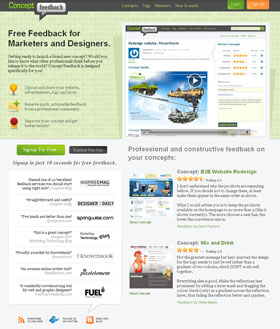Lots of people design sites based on what they would like to see. However, what makes sense to a designer may not make sense to the target audience. If designers seek to create a conversion-friendly web experience, we’re going to have to learn about our audience and what makes them tick.
As I write this I am sorting through old non-work-related emails from employees at a company that hired me to do PR. Some of these emails are interesting or hilarious to me. These emails that engage me or make me laugh are usually from people at the company that I know well and that are in my demographic (mid 20s, male, work in marketing, a little geeky, etc.). However, most of the joke emails that I get are completely uninteresting and/or unfunny to me, not to mention a frustrating waste of my time.
What’s interesting though is that many people at this company love the joke emails that I loathe, and vice versa. The women that work in accounting are in their mid-50s and do not enjoy getting “Rick Roll’d” or reading Seth Godin posts like I do, but they love getting pictures of cute cats in shoeboxes and recipes for tomato soup (two examples of emails that I despise).
Different audiences find different things meaningful, and improving conversions on our sites depends upon our understanding that there is no uniform way that people think and act, especially on the web. In this piece we’ll explore useful principles for connecting with audiences as well as practical steps to better understand and act on our audience’s habits and practices.
Create web experiences based on your audience and their needs
While there are many ways to create conversion-friendly web experiences, two principles are clear:
-
Appealing copy

Appeal to your audience…or risk losing them.
A broad and seemingly self-evident statement to be sure. But verbiage often plays second fiddle to other site elements, and I think this is a big mistake. From headlines to captions to your FAQs, the words on your site must be easily understood and play into the mind and habits of your audience.
How do you do this? One strategy I recommend is avoiding words and phrases that do nothing to move your target audience to conversion. When you are writing for your site, try to think about each word and phrase that you use as products themselves; if your verbiage isn’t explicitly doing something meaningful for your audience, they will soon stop “buying” what you are “selling” (reading your copy), and ultimately leave your site. Therefore, it helps for your wording to be as intentional and helpful as possible to your audience, as opposed to vague and neutral.
Here’s an example. Let’s say a manager at an auto parts store is looking for some cheap computer monitors, so he is researching local office technology companies. Which one of these statements on the office technology company homepage do you think is more enticing and motivating to the manager?
ACME Computers, Inc. provides customer-centric technology solutions that can help you expand your business at minimal investment to your company
or
ACME Computers, Inc. wants to help you find the best computer hardware at the lowest price to meet your specific needs
My bets are on the second statement for this particular customer. However, I might be inclined to vote for the first statement if the company were a national technology company and the potential customer worked at an investment firm. The key is to remember that your audience is first and foremost human beings before being customers or prospects, and they have their own likes, dislikes, hobbies such as betting on Betfred Near Me, and jobs that make them who they are. You need to respect this, even on something as simple as a company description.
But creating successful site copy isn’t just learning how to say something; many times it’s learning what to say. You might not be selling written content as your product, but having interesting writing on your site can be great for business, as long as it is meaningful for your audience. Blog posts, articles, case studies, white papers, and anything else written that you feature on a site needs to be something that someone from your target audience would find interesting, humorous, or engaging, and it should never turn them off to what you are selling or promoting.
One interesting example is EdRoman.com, the website for a popular high-end guitar store in Las Vegas. The site has a “Rants” section where the owner of the store Ed Roman writes long-winded and pointed diatribes on why large corporate guitar companies, and their cheap guitars, stink. This seems like an unadvisable or unprofessional strategy, but I actually think that it’s a brilliant move on his part. Ed knows that his wealthy older audience is primarily interested in custom-made, high quality guitars and that they are more than willing to second his complaints. By fueling the fires of hatred towards large corporate guitar companies, Ed is building strong rapport with those who feel the same way he does and alienating no one that would actually buy anything from him.
-
Appealing design
Again, seemingly a no-brainer. But what we consider “good” design might not best fit our target audience. The marketing team I work with learned this the hard way when we worked on a website for a company that provides industrial and facility services. We produced a very sleek, colorful site, reflecting our contemporary tastes and preferences. This design would have been great if our audience had been 25-year-old marketing professionals that read the magazineWired and spent several hours a day online with their Macs. However, our real audience consisted primarily of building facility managers in their mid-40s that read the magazineCleaning and Maintenance Management and are just now learning to use “the Google.” The site didn’t bomb, but we ended up having to make significant changes later on to reflect the aesthetic tastes and navigation habits of our audience.
In regards to aesthetics, we must make sure that we know what our target audience wants to look at. The design schemes, colors, font types, and even the stock photos must make our users feel at home while they are browsing. If we sell a sleek, cool, and innovative product, then by all means let the design communicate that. But if we hawking goods and services that aren’t sexy, then perhaps we should go with something a little more conservative. Think of sites as having a “culture” or “atmosphere” (Editor’s note: perhaps ambience?) in the same way that a restaurant or retail store would; good eateries and stores know what kind of lighting, background music, and employees their clientele expect. You would probably feel weird buying 2x4s, hammers, and nails from a geeky 22-year-old salesperson in place that looks like an Apple store, and no one wants to purchase a $1500 computer from a place with bare concrete floors, industrial shelving, and muscled men with orange aprons.
Another aspect to consider is our site’s functionality and processes. As designers, we know how to do basic site functions when making a purchase (first I read about the product, then I might check the FAQs, then I add to cart, then I check out, etc.). However, while these actions seem basic to us, they might be confusing for our users, or possibly unnecessary. One recent experience I had was trying to figure out the best way to sell a $3500 piece of industrial equipment on a client’s site. My team and I discovered that our target audience of facility engineers in their 40s and 50s was very open to learning about our product online (watching demo videos, reading FAQs, etc.). However, when it came to actually purchasing the product, they were uncomfortable with ordering through our e-commerce site, even when they’d already made up their minds to buy it. Therefore, we made sure that we always included our company’s phone number in a prominent place on all site pages so they could call and order in person from a sales rep. Our older audience placed a high value on human contact when it came to making a purchase, so we designed our site’s functionality in a way that encouraged it.
Practical steps to take to learn your audience’s language
Learning to speak your audience’s language by building sites based on their preferences isn’t always easy. There’s a good chance that you aren’t part of the demographic you are targeting, so here are a few ideas to help you start understanding who you are talking to when you design:
1. Before building a site, immerse yourself in the “culture” of your audience
How does my audience browse the web? What types of color schemes, pictures, and verbiage do they prefer? What motivates them to convert? These questions would be answered differently depending on who you are talking to, and you need to know these answers before you start building a site. You could pay a consultant a ton of money to answer these questions for you, or you could start taking these two steps to find out yourself:
Step 1: Read what your audience reads
Before you start a project, take a few days to read (or watch) as many things as you can that were created for (not about) your audience. Whether it’s blog posts, magazine articles, or even YouTube videos, this firsthand perspective will be a great crash-course in discerning your audience’s tastes and learning their vocabulary. An exercise like this very well might bore you to death (trust me, I’ve read more industrial facility supply magazines than should be legally allowed), but therein lies the grand point: you don’t yet understand why this “boring” material is exciting and motivating for your audience. You don’t need to force yourself to like anything, but you have to respect the logic behind the choices that your target audience makes or you will lose them completely.

You need to read what your audience reads to understand them (even if it bores you to death).
Step 2: Learn from and improve on others who have already successfully learned your audience’s language
Let’s say I’m building a site for an audience of brides and female newlyweds (there’s big money to be made here!). I personally appreciate minimalist design elements and I like seeing one large in-depth piece of text per page. However, one look at successful wedding sites like TheKnot.com and WeddingChannel.com tells me that I have to rethink what I view as interesting and aesthetically pleasing when I’m working on this project. Just browsing through these sites tells me a lot about what some successful strategies might be (soft colors, lots of different text elements happening at once), and even though I’m not personally attracted to how the sites look or operate, I know that millions of brides-to-be and newlywed women love this stuff. I don’t need (or want) to copy anything that TheKnot.com or WeddingChannel.com has done, but I need to be aware of the commonalities between the sites and the web habits/culture that they are drawing from and building on themselves.
2. Get feedback
Once you’ve learned your audience’s language and you have implemented your strategy, it’s important to hear from others to see what they think. Feedback can affirm your good ideas and alert you to mistakes you have made, giving you information about strategies to continue and reconsider.
Who should you get feedback from? The first obvious choice: your target audience. There are many ways for you to get their feedback (user surveys, focus groups, etc.), but you need to make sure that you have the input on what you have created.
However, I would also argue that getting feedback from certain people outside your target audience is equally, if not more, important. Who are these people? Pretty much anyone that understands your target audience’s perspective and that can give you actionable feedback. While your understanding of your audience is key, chances are they have little to say when it comes to actual web design or site usability—they might subconsciously know what they want on the web, but they have no idea what to say when you ask them what font style or user experience type they prefer. At best they might give you feedback like “I don’t like that,” or “Hmm, sure, that looks good to me”—both are very unhelpful.
This is where your fellow web designers come in. You need people that can tell you exactly what to change or keep the same in your work. This is actionable feedback—criticism that is specific and that you can actually do something with once you receive it. It might not even be necessary for those giving you actionable feedback to be intimately familiar with your target audience; a brief explanation from you about your strategy and goals should be good enough for some helpful results.
Good resources for getting feedback
There are some great resources on the web for those looking for actionable feedback. Here are a few I’ve found to be helpful:

ConceptFeedback.com provides free feedback for web designers, developers and marketers
Concept Feedback (Update: Closed in 2016)
A free feedback tool based on a community of designers, freelancers, and marketers (shameless plug for my own site!)
Feedback Army
This is an easy usability test for your site that only costs $10. Get text feedback from 10 other people about questions that you specify.
UserTesting.com
Another paid usability test that is low-cost and easy to sign up for. Has the ability to view users’ browsing sessions and hear their spoken comments.
Userfly
A really neat paid tool that allows you to view and record all of your site visitors’ browsing sessions. Has a free demo that lets you view 10 recordings per month.
About the Author

Aaron Griffith is a B2B marketer for Air Cycle and LampRecycling.com. Aaron also writes and markets for Concept Feedback, a community of designers and marketers dedicated to sharing ideas and feedback on design projects.
UX research - or as it’s sometimes called, design research - informs our work, improves our understanding, and validates our decisions in the design process. In this Complete Beginner's Guide, readers will get a head start on how to use design research techniques in their work, and improve experiences for all users.